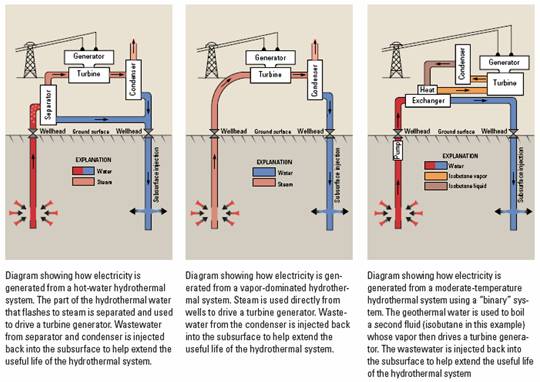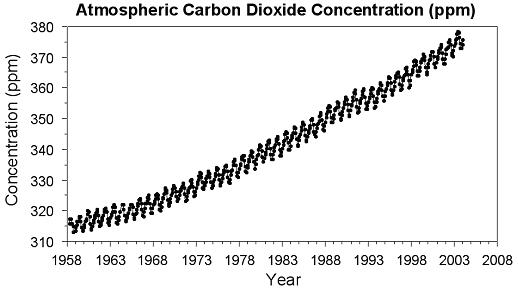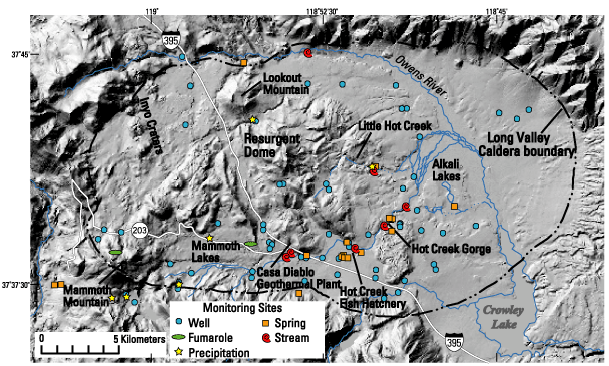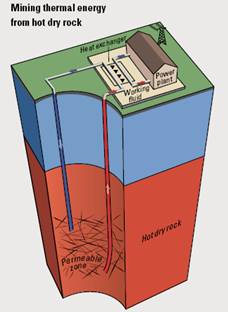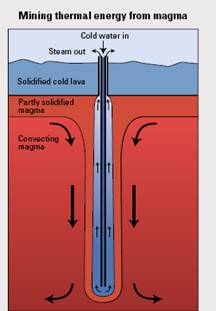Geology and Natural Heritage of the Long Valley Caldera
Geothermal Energy
Jordan Schnell
ABSTRACT
Geothermal energy is a very underdeveloped source of energy that has the potential to help solve the world’s energy problems. There are so many uses, both commercial and private, of geothermal energy and it should be exploited to the full extent capable. With little environmental impact and it being a renewable resource, there is not much of an argument against geothermal energy. Although it requires more of an overhead cost, the payoffs in the long run are well worth the initial investment. Geothermal plants should one day power the homes of millions of people, including mine.
“Even if only one percent of the thermal energy contained within the uppermost 10 kilometers of our planet could be tapped, this amount would be 500 times that contained in all oil and gas resources of the world [Duffield and Sass, 2003].” There is so much energy that has not been tapped right underneath our feet. A world of swirling hot magma, volatile steam, and boiling water is lying anywhere from a few hundred meters to a few thousand meters right below us. Tectonic activity is a window into this heat and the world needs to look through it to help solve future energy problems. The world fossil fuel supply is running out and they are being used at an increasing rate. “Coal and fossil fuel hydrocarbons are the principal sources of energy for the United States . Together they account for about 95 percent of our Nations energy consumption [Duffield and Sass, 2003].” This is a huge problem that can easily be fixed with alternative fuel sources like geothermal energy.
Explanation of Geothermal Processes and Plants:
Tectonics- The Earth is composed of a series of plates. These plates are situated on top of the mantle. They are connected through a series of boundaries. These boundaries provide a way for the heat energy inside of the Earth to come up near the surface. Geothermal plants try to find places where this heat energy is near the surface so drilling does not have to be as deep. This energy is usually in the form of very hot water under pressure or steam. However, it is sometimes hard to find exactly where the water is located. So, geologist look for hydrothermal activity underneath the surface by using what is on the surface. In areas such as the Long Valley Caldera, there are places where the water underground comes up to the surface. Hot Creek in Long Valley is an example of a place where water from inside the Earth bubbles up to the surface. There are also fumaroles or steam vents where water vapor rises to the surface. Both superheated water under pressure and high pressure steam exist beneath the surface and can both be used in geothermal plants.
Types of Plants- There are three main types of hydrothermal water storage in which geothermal plants use to produce electricity. There are hot water plants in which the water is hot enough to be flash boiled to steam when it reaches the surface. There are also less abundant steam plants where steam is trapped beneath the surface and is brought to the surface to power turbines. Finally, there are moderate temperature water plants in which the water is brought to the surface and used to boil an intermediate substance to power the turbines. All three work in very similar ways. A production well is necessary to bring the water or steam to the surface where it can be used. They can be very deep or shallow, only depending on where the hydrothermal deposit is located. In the Long Valley area, the Mammoth Pacific plant's twelve wells are only at a depth of 500 ft. After it is brought to the surface, it is either ran directly through the turbines if it is steam, ran through a separator if it is hot water, or ran through a heat exchanger if it is a moderate temperature plant. The Mammoth Pacific plant uses moderate temperature water and the heat exchangers take water that is about 300-350 degrees Fahrenheit and knock it down to about 150 degrees Fahrenheit. This water is used to heat the isobutene from about 40-100 degrees Fahrenheit to about 280 degrees. It is changed from a liquid to a high pressure gas where it then powers the turbines. [Mammoth Pacific, Ormat]
Hot water plants use superheated water that is trapped under pressure beneath the surface. This water can be upwards of 300 degrees Celsius and can stay in the liquid state due to the very high pressure. This hot-water is brought to the surface through pipes drilled into the reserve. As it is brought to the surface, some of it flash boils due to the rapid decrease in pressure. The steam produced is then used to turn a turbine and in turn produce energy. The steam then goes through a condenser and the wastewater from out the turbines along with the part of the hydrothermal water that did not flash to steam is then pumped below the surface so as to prolong the life of the hydrothermal system and to reduce surface water pollution.
Some hydrothermal reserves contain only steam instead of superheated water. These systems are created when there is a very strong heat source and little water in the area. The steam that is produced from these systems is fed directly into the turbines at the power plant. Since the water is already in the form of steam, no separation of water from steam is needed. Therefore, this is the system that is most sought after due to economic feasibility, however these systems are not very common. A very large vapor dominated system has been created at The Geysers in California . Calpine's © website states that they own and operate 19 of the 21 plants at the Geysers. These plants can produce about 750 megawatts of electricity. The steam at the Geysers is trapped beneath the surface by what is known as a cap rock. The turbines producing the electricity “ are designed to operate with steam at 350 degrees Fahrenheit and 100 ponds of pressure per square inch. About two million pounds of steam per hour are necessary to operate a 110- megawatt-generating unit” [Calpine ©].
Finally there are moderate temperature water plants where the water is not hot enough to flash boil, but is used to heat a secondary substance to power the generators. The secondary substance can be a number of things including isobutene and hexane. In this process, the water is pumped from the reserve and brought to the surface. The water goes through a heat exchanger where it heats the secondary fluid and boils it. The secondary fluid is then recycled and goes through a condenser where it can be reboiled to start the process over. Wastewater once again is pumped back into the hydrothermal system. This process is used in the Long Valley Region- “ Wells drilled on the southwest side of the resurgent dome at Casa Diablo tap into the caldera's hydrothermal system by pumping hot water (170°C) to supply three hydrothermal power plants that generate about 40 megawatts of electricity [USGS Hydrologic Studies, 2003].”
A diagram of the three types of systems is shown below:
[Duffield and Sass, 2003]
Private Sector- Geothermal heat does not only have to be used as a means to produce electricity. Geothermal heat can be used for space heating, hot water heating and other applications. Geothermal heat pumps can be very useful in heating and even cooling buildings almost anywhere. Installing these pumps are more expensive than conventional heating at first but over time, the energy savings will make up for the initial cost. In Iceland “87 percent of all buildings are heated with geothermal water [Duffield and Sass].” Heat pumps are a great way to cut back on fossil fuel consumption and a fairly efficient way of heating and cooling one's home. In Oregon , municipal water is pumped below the surface through pipes and heated by the geothermal water. In this process, the hydrothermal system is not being tapped so as not to disturb the natural reserve. Geothermal heat can be used in so many ways. Some homes actually use the water to run through pipes embedded beneath sidewalks and driveways to melt the snow during the winter.
Pros and Cons of Geothermal Energy:
Environmental Issues- “A typical geothermal plant using hot water and steam to generate electricity emits about 1 percent of the sulfur dioxide, less than 1 percent of the nitrous oxides, and 5 percent of the carbon dioxide emitted by a coal-fired plant of equal size” [Duffield and Sass, 2003].” Today one of the biggest issues facing us is that of fossil fuel depletion and global warming. Over the past 200 years, industrialization of the world has caused an explosion of need for fossil fuels. Due to this, greenhouse gas production has also grown exponentially. Carbon dioxide concentration especially has risen substantially as shown in this figure.
Figure 1. Complete monthly record of the atmospheric carbon dioxide concentration (ppm) as measured from Hawaii 's Mauna Loa observatory, 1958-2003. [World Climate Report, 2004]
If we continue to burn our remaining fossil fuels and still at an increasing rate, our fossil fuel supply will most likely be on the verge of depletion. Whether it is from natural cycles in the Earth's climate or from increased production of fossil fuels, the fact is that the Earth is getting warmer and is most likely from human impact. The bottom line is that we as humans need to find alternative energy sources. “Using current technology, geothermal energy can contribute as much as 10 percent to the Nation's energy supply, if all known resources are fully developed” [Duffield and Sass, 2003]
Environmental impacts of geothermal plants are much less than that of typical power plants. As mentioned above, greenhouse gas emissions are almost negligible compared to that of a coal fired plant. Also, this is for hot water and steam powered plants. Emissions of moderate temperature water are absent due to none of the hydrothermal water ever being released into the air. Land usage of the geothermal plants plays some part in determining the impact of a geothermal plant. Obviously is does require some land to develop a plant, however, after many of the pipes and wells are installed, the land is often used for grazing and therefore the impact is minimized. Geothermal fields use on average about 1-8 acres per MW hour generated compared to the 5-10 acres per MW for nuclear power plants and 19 acres per MW for coal power plants. Also coal power plants require huge mines to get the coal needed for their plants. These mines can take up massive amounts of space and require the need to destroy so much land [USDE, 2006]. Another impact of geothermal plants has to do with the leftover cooled wastewater after the heat has been extracted. In the past, wastewater was just left to empty onto the surface, but now the water is in almost every case, injected back into the reserve from which it was drawn. This is to cut back on the chances of contaminating surface waters that would be used for private use. Also, it preserves the life of the hydrothermal system by sustaining the amount of water in the reserve thus extending the life of the geothermal plant itself.
A geothermal plant could also possible affect surface features such as geysers and fumaroles which are scenic attractions. Removing water from a hydrothermal reserve could possibly stop or change the way surface features act. In places like Yellowstone , these are highly visited areas prized for their scenic quality. If they were to deplete, the economic impact of the park could suffer since geysers such as Old Faithful are a huge attraction for the park
Finally, there is a chance that the re-injection of the wastewater could cause increased seismic activity. There has been evidence at The Geysers for increases activity since the power plants have been installed. In the Long Valley area, the USGS monitors features such as fumaroles and springs to study the impact. They have detected some changes in the hydrologic system. They have “delineated decrease in thermal-spring discharge at sties within about 5 km to the east of Casa Diablo that are caused by subsurface pressure declines at the geothermal well field.” There also has been a slight increase in some fumarole activity due to increased boiling in the reserve [USGS Hydrologic Study]. A diagram of the area and where such monitoring stations are located is shown below.
[USGS Hydrologic studies, 2003]
Through these monitoring stations, the USGS will be able to determine if there is a change in the way that natural features are occurring. They have shown that a few vents have opened and some have shut down most likely because of the taking out and re-injecting of hydrothermal water. However, this could also be due to tectonic activity that can shut off or open up such features.
Cost and Feasibility- The initial costs of constructing a geothermal plant can be very expensive. It takes a lot of drilling to discover exactly where the hydrothermal features are. It takes research to determine whether or not the impact of the wells will be great. The wells are very expensive to create and they must be created at the same time as the power plant which is also expensive.
Geothermal plants are very reliable. The heat from the Earth is available all the time and the plants are off line only about 5 percent of the time [Duffield and Sass, 2003]. Geothermal heat is also here in the US so we do not have to import energy sources from other countries.
Geothermal heat is a renewable resource. This is because of an almost unlimited amount of heat stored beneath the Earth's crust. Hydrologic features can and do run out but due to the re-injection of the wastewater, the life of the feature is greatly prolonged.
Geothermal Energy in the Future:
New Technologies- Geothermal energy can, in the future play a huge part in supplying the world with energy. As the cost of producing electricity from hydrothermal deposits decreases, more and more locations are becoming economically viable to produce electricity. Also, new techniques are being researched so more potential is being created. The two main types of new techniques are the “hot dry rock” and the magma technique.
The hot dry rock technique is a simple idea but sometimes not as easy as it sounds. All around the world are places where the rocks are very hot and contain tons of energy but no water is around. So a process called hydraulic fracturing is being tested. This process involves injecting loads of water into the rock causing the pressure to rise. This pressure rise causes the rocks to break increasing the permeability. Then two wells are created. One well delivers cold water from any source and allows the water to percolate through the rocks. As it passes through the rocks, it heats up. It is then picked up by another well and brought to a power plant nearby. This technique is growing fast and is being tested in Japan , Germany , France , England and the U.S [Geothermal Education Office, 2004] .
Another technique that is being researched is that in dealing with magma. Magma, or molten rocks, has the highest heat content of any geothermal source. If the heat in magma could be harnessed to the full extent a huge burden of energy demand could be met. To do this, some sort of pipe would be put into the magma body. Cold water would then be pumped into the pipe and heated by the magma and the surrounding pipe. This water would vaporize into steam and rise back to the surface to power turbines. A few problems exist with this idea. One must first locate a magma body to be used. The only for sure way to locate a magma body is by drilling and to drill and miss is a very costly mistake. Another problem is the material that must be used to construct the piping for the project. The material must be able to withstand extreme heat so as not to melt and distort in the face of temperatures reaching 1300 degrees Celsius. Another problem exists where magma that loses its energy to the water inside the tubing with harden and collect on the tube. This hardened magma must someone be scraped off to maximize heat transfer between the magma and the water. Someday, magma may be a primary energy source for the country and other parts of the world, but as of now too many obstacles lie in the way of creating an efficient way a obtaining a usable form of energy from the magma [Duffield and Sass, 2003]. The figures below depict the two new technologies mentioned previously.
[Duffield and Sass, 2003]
Improving Existing Technologies- Improving existing processes is one of the main sources of researching going on in the industry. Harnessing lower temperature heat sources and using the byproducts created by plants are two of the biggest improvements being made. By trying to use lower temperature heat sources, availability of production wells increases. Also by using the byproducts of production for other uses cuts back on environmental losses. For example, in some plants, silica coming out of the wells is being used for concrete. In others Hydrogen Sulfide is being converted into sulfur and in others zinc is being drawn from the water to be sold [Geothermal Education Office, 2004].
In conclusion, geothermal energy needs to be explored to the full extent. With little environmental impact and as a renewable resource it is a wonderful way to produce electricity. With so many different ways of producing it and the new technologies being researched, it could power the homes of millions of people for years and years to come.
References:
Duffield, W.A. and J.H. Sass, 2003, Geothermal Energy-Clean Power From the Earth's Heat , US Geological Survey, pp. 1, 10-11, 18, 20-23, 26-27, 33.
ORMAT Handout, Mammoth Pacific, 3 pp.
Calpine ©, The Geysers Website: http://www.geysers.com/default.htm
USGS Hydrologic Studies, Hydrologic Studies in the Long Valley Area: http://lvo.wr.usgs.gov/HydroStudies.html
US Department of Energy, Geothermal Technologies Program: http://www1.eere.energy.gov/geothermal/faqs.html
Geothermal Education Office, Geothermal Energy Facts: http://geothermal.marin.org/geoenergy.html#improve
World Climate Report, Atmospheric Carbon Dioxide Concentration: http://www.worldclimatereport.com/index.php/2004/10/12/much-ado-about-nothing/
